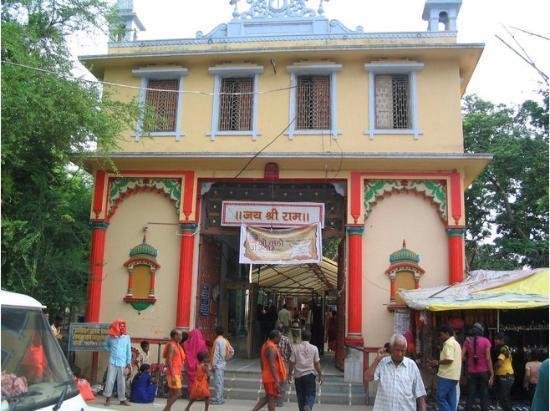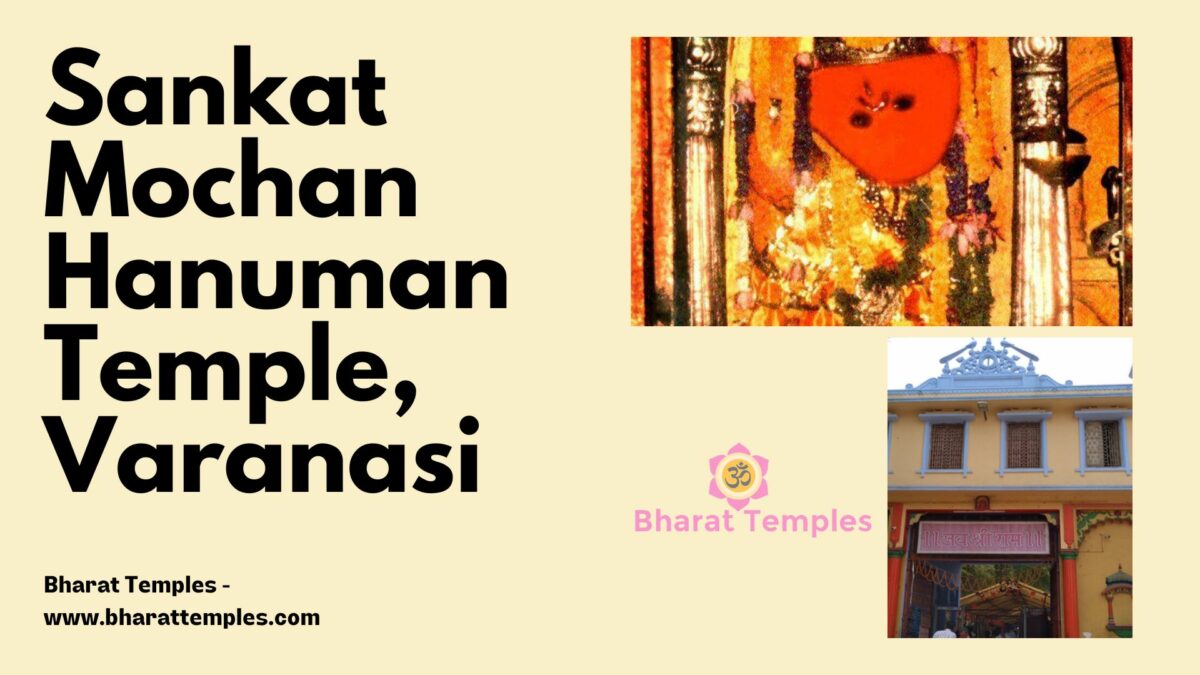Contents
The Sankat Mochan Hanuman Temple is one of the most popular and revered.

Sankat Mochan Hanuman Temple is a Hindu temple in Varanasi, Uttar Pradesh, India and is dedicated to the Hindu God Hanuman. The temple was established by famous Hindu preacher and poet-saint Sri Goswami Tulsidas in the early 1500s and is situated on the banks of the Assi river. The deity was named “Sankat Mochan” meaning the “reliever from troubles”. Tulsidas is believed to have written most of the verses of Ramacharitramanas in this temple.
In the temple, offerings to Lord Hanuman (called Prasad) are sold like the special sweet “besan ke ladoo”, which the devotees relish; the idol is also decked with a pleasant marigold flower garland as well. This temple has the unique distinction of having Lord Hanuman facing his Lord, Rama, whom he worshipped with steadfast and selfless devotion.
No photography is allowed inside.
| Date built: | 18th century |
|---|---|
| Deity: | Hanuman, Rama |
| Architectural style: | – |
| Major festivals | Hanuman Jayanti, Ram Navami, Sankat Mochan Sangeet Samaroh |
| Locale: | – |
| District:: | Varanasi |
| Address: | Sankat Mochan Mandir, Varanasi, Uttar Pradesh 221005 |
| Phone | – |
Spiritual Significance
The Sankat Mochan Hanuman Temple is considered one of the most powerful and auspicious temples in India. It is believed that Lord Hanuman, who is revered as the symbol of strength, courage, and devotion, can fulfill the wishes of his devotees and protect them from all evils and obstacles.
The temple is particularly popular among students, scholars, and intellectuals, who come here to seek the blessings of Lord Hanuman for success in their academic pursuits. It is also a popular destination for devotees who are facing problems and difficulties in their lives, as it is believed that Lord Hanuman can remove all kinds of obstacles and challenges.
Festivals and Celebrations
The Sankat Mochan Hanuman Temple is a hub of activity throughout the year, with several festivals and celebrations being held here. One of the most popular festivals celebrated here is the Hanuman Jayanti, which marks the birth anniversary of Lord Hanuman. Thousands of devotees throng the temple on this day to offer prayers and seek blessings.
Other important festivals celebrated at the temple include Navratri, Diwali, and Holi. During these festivals, the temple is decorated with lights and flowers, and special puja and aarti ceremonies are performed.
Each year in the month of April, the temple organizes classical music and dance concert festival titled “Sankat Mochan Sangeet Samaroh“, in which musicians and performers from all over India take part. The first festival was organized 88 years ago, and it has invited musicians and dancers including Odissi guru Kelucharan Mahapatra, who was associated with since its early days. In fact, he was instrumental in starting women’s participation in the festival with Sanjukta Panigrahi, Swapna Sundari, and Kankana Banerjee
History and Legend
The Sankat Mochan Hanuman Temple, also known as the Sankat Mochan Mandir, is dedicated to Lord Hanuman, the monkey god, who is one of the most popular deities in the Hindu pantheon. The temple was established in the early 1900s by the famous Hindu saint and social reformer, Swami Karpatri Ji Maharaj, who was a disciple of the legendary saint, Swami Ramanuja Acharya.
According to legend, the temple was built on the spot where Lord Hanuman appeared in the dreams of Swami Tulsidas, the author of the famous epic, Ramcharitmanas, and blessed him with his divine presence. It is said that Lord Hanuman himself revealed the location of the temple to Swami Karpatri Ji Maharaj in a dream.
Architecture and Design
Tulsidas is believed to have written most of the verses of Ramacharitramanas in this temple.
The Sankat Mochan Hanuman Temple is an impressive structure that blends the traditional Hindu architectural style with modern elements. The temple complex comprises several buildings, including the main shrine, the Hanuman Chalisa Hall, the Vedic School, and the Dharamshala (guesthouse).
The main shrine, which houses the idol of Lord Hanuman, is a magnificent structure with a high ceiling and intricate carvings. The idol of Lord Hanuman, which is made of brass, is four feet tall and has a bright orange color. The Hanuman Chalisa Hall, which is located next to the main shrine, is a spacious hall that can accommodate hundreds of devotees. The walls of the hall are adorned with beautiful paintings and murals that depict the life and deeds of Lord Hanuman.
Legend / Local stories
It is believed that the temple has been built on the very spot where Tulsidas had a vision of Hanuman. Sankat Mochan Temple was founded by Tulsidas who was the author of the Ramacharitamanasa, which is the greatest version of lord Ram story written in Avadhi(“Most of the people having confusion that Ramacharitamanasa is a Awadhi version of Valmiki Ramayana but Ramacharitamanasa is different from Sanskrit Ramayana written by Rishi Valmiki as Baba Tulsidas Ji already told in Ramacharitamanasa that “Nana bhanti Ram avatara, Ramayan sat koti apara” means in each Kalp lord Ram takes Avatar & plays different-2 lilas(Act) so we have different stories of same lord Ram”). Tradition promises that regular visitors to the temple will gain the special favour of Lord Hanuman. Every Tuesday and Saturday thousands of people queue up in front of the temple to offer prayers to Lord Hanuman. According to Vedic Astrology, Hanuman saves human beings from the anger of the planet Shani (Saturn), and especially people who have an ill-placed Saturn in their horoscopes visit this temple for astrological remedies. This is supposed to be the most effective way for appeasing Shani. While it is suggested that Hanuman did not hesitate to engulf in his mouth the sun, the lord of all planets, which humbled all the gods and angels, making them worship him for the Sun’s release. Some astrologers believe that worshipping Hanuman can neutralize the ill-effects of Mangal (Mars) and practically any planet that has an ill effect on human life.
Photo Gallery




How to Reach:
The Sankat Mochan Hanuman Temple can be easily reached by various modes of transportation. The nearest airport to Varanasi is the Lal Bahadur Shastri International Airport, which is located about 25 kilometers from the temple. From the airport, you can hire a taxi or take a pre-paid taxi to reach the temple.
Varanasi is well connected by rail to all major cities in India. The Varanasi Junction railway station is the main railway station in the city and is located about 8 kilometers from the temple. From the railway station, you can hire a taxi or take a rickshaw to reach the temple.
The temple is also well connected by road, and there are several state-run and private buses that ply between Varanasi and other major cities in Uttar Pradesh and neighboring states. You can also hire a taxi or take an auto-rickshaw to reach the temple.
Contact Details
Official Address
Frequently Asked Questions about Sankat Mochan Hanuman Temple
No, you can directly visit the temple. The temple is crowded on Tuesdays & Saturdays. You can visit the temple normally without advance booking.
Laddoo, and various other sweets are sold as prasad inside the temple. Devotees should buy from there.
There are many attractions near this temple such as Tulsi Manas Temple,
Yes, there are several guesthouses and hotels near the temple where you can stay.
Yes, the temple is wheelchair accessible, and there are ramps and elevators available for people with disabilities.












